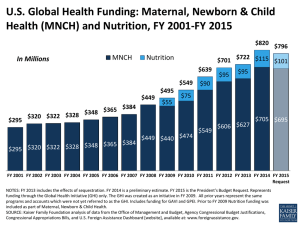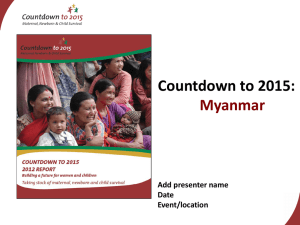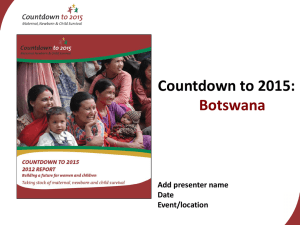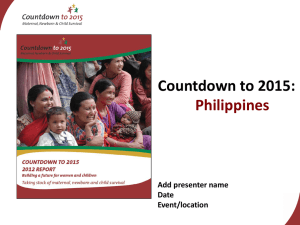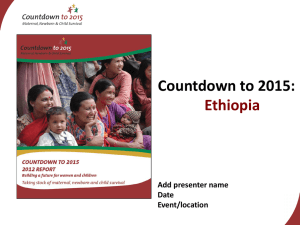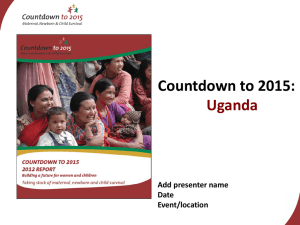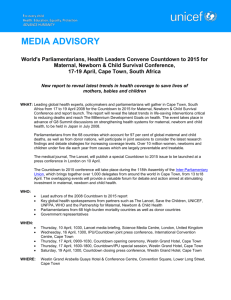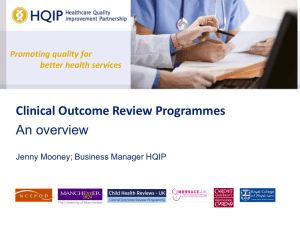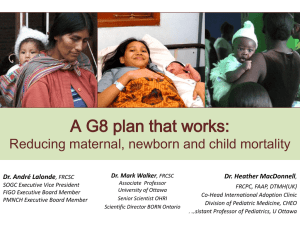Countdown Report 2012, CS-C2A June 2012
advertisement
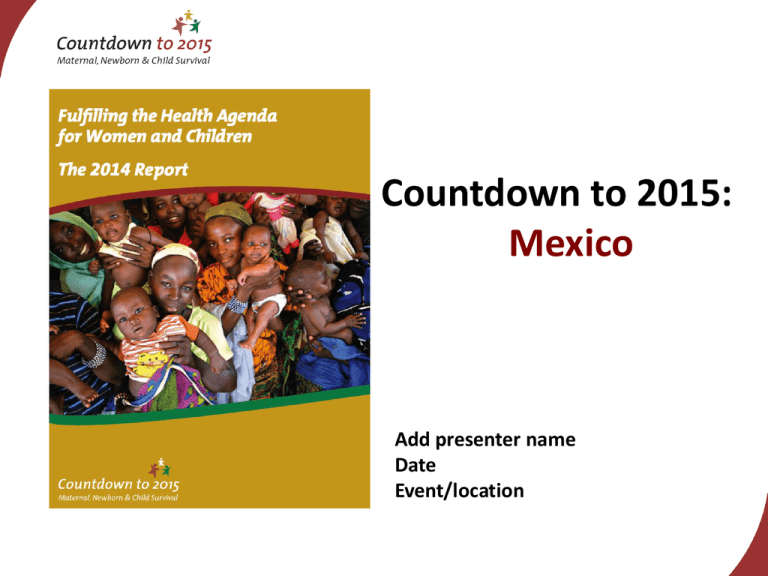
Countdown to 2015: Mexico Add presenter name Date Event/location Notes for the presenter on adapting this presentation • Personalise with photos, charts • Data presented are based on best available data up to mid-2014. When presenting, mention more recent studies or data. (2013 mortality on slide #18 added) • Select which slides are appropriate for the audience. For example: Slides are provided for each figure presented in the country profile; select from these (choosing all or a few depending on needs) • Sub-national data can be substituted as appropriate and available • Review the Speaker Notes, adapt according to your audience and purpose Purpose of this presentation • To stimulate discussion about Mexico country data, especially about progress, where we lag behind, and where there are opportunities to scale up • To provide some background about Countdown to 2015 for MNCH, the indicators, and data sources in the country profiles • To showcase the country profile as a tool for monitoring progress, sharing information and improving accountability Outline 1. Countdown to 2015: Background 2. Mexico Countdown profile Part I Countdown to 2015: Background What is Countdown? A global movement initiated in 2003 that tracks progress in maternal, newborn & child health in the 75 highest burden countries to promote action and accountability Countdown aims • To disseminate the best and most recent information on country-level progress • To take stock of progress and propose new actions • To hold governments, partners and donors accountable wherever progress is lacking What does Countdown do? • Analyze country-level coverage and trends for interventions proven to reduce maternal, newborn and child mortality • Track indicators for determinants of coverage (policies and health system strength; financial flows; equity) • Identify knowledge and data gaps across the RMNCH continuum of care • Conduct research and analysis • Support country-level Countdowns • Produce materials, organize global conferences and develop web site to share findings 9 75 countries that together account for > 95% of maternal and child deaths worldwide Who is Countdown? • Individuals: scientists/academics, policymakers, public health workers, communications experts, teachers… • Governments: RMNCH policymakers, members of Parliament… • Organizations: NGOs, UN agencies, health care professional associations, donors, medical journals… 12 Countdown moving forward Four streams of work to promote accountability, 2011-2015 • Responsive to global accountability frameworks -Annual reporting on 11 indicators for the Commission on Information and Accountability for Women’s and Children’s Health (COIA) -Contribute to follow-up of A Promise Renewed/Call to Action • Production of country profiles/report and global event(s) • Cross-cutting analyses • Country-level engagement Part 2 Mexico Countdown country profile Main findings data on the profile WhatRange doesofCountdown monitor? • Progress in coverage for critical interventions across reproductive, maternal, newborn & child health continuum of care • Health Systems and Policies – important context for assessing coverage gains • Financial flows to reproductive, maternal, newborn and child health • Equity in intervention coverage Sources of data The national-level profile uses data from global databases: • Population-based household surveys • UNICEF-supported MICS • USAID-supported DHS • Other national-level household surveys (MIS, RHS and others) • Provide disaggregated data - by household wealth, urbanrural residence, gender, educational attainment and geographic location • Interagency adjusted estimates U5MR, MMR, immunization, water/sanitation • Other data sources (e.g. administrative data, country reports on policy and systems indicators, country health accounts, and global reporting on external resource flows etc.) National progress towards MDGs 4 & 5 Mortality data through 2012: 2013 child mortality data was released in late 2014: Under-five mortality rate (U5MR)= 15 deaths per 1000 live births Infant mortality rate (IMR) = 13 deaths per 1000 live births Neonatal mortality rate (NMR) = 7 deaths per 1000 live births Why do mothers in the LAC region die? Leading direct causes: Hypertension –23% Haemorrhage – 22% Unsafe abortion – 10% Sepsis – 8% Embolism – 3% Understanding the cause of death distribution is important for program development and monitoring M exi c o Why do Mexican children die? DEMOGRAPHICS Causes of under-five deaths, 2012 Pneumonia Leading causes: Neonatal – 44% Pneumonia – 9% Injuries – 7% Diarrhoea – 3% 9% Preterm 16% 2% Other 36% Neonatal death: 44% Ca Globally nearly half of child deaths are attributable to undernutrition Asphyxia* 6% Other 3% Congenital 11% Sepsis** 6% HIV/AIDS 0% Malaria 0% Injuries 7% 0% 3% Measles 0% * Intrapartum-related events Diarrhoea Source: WHO/CHERG 2014 ** Sepsis/ Tetanus/ Meningitis/ Encephalitis MATERNAL AND NEWBORN HEALTH Undernutrition is a major underlying cause of child deaths Antenatal care Percent women aged 15-49 years attended at least once by a Dem Demographics Countdown to 2015 Report. 2014. Variable coverage along the continuum of care Maternal and newborn health Maternal and newborn health * Intrapartum-related events Source: WHO/CHERG 2014 ** Sepsis/ Tetanus/ Meningitis/ Encephalitis Maternal and newborn health MATERNAL AND NEWBORN HEALTH Antenatal care Demand fo Percent women aged 15-49 years attended at least once by a skilled health provider during pregnancy Antenatal c 100 Percent 80 78 86 96 98 Malaria du treatment C-section r (Minimum ta 60 Neonatal te 40 Postnatal v (within 2 day 20 Postnatal v (within 2 day 0 1987 Other NS 1995 Other NS 2004-2009 Other NS 2006 Other NS Women wi (<18.5 kg/m2 alitis birthw Other maternal and newborn health indicatorsAnten ALTH mana Demand for family planning satisfied (%) 88 (2009) Antenatal care (4 or more visits, %) 86 (2009) - - 46, 49, 36 (2012) Low o mana 88 (2012) - - SYS Malaria during pregnancy - intermittent preventive treatment (%) C-section rate (total, urban, rural; %) (Minimum target is 5% and maximum target is 15%) Neonatal tetanus vaccine Postnatal visit for baby (within 2 days for home births, %) Postnatal visit for mother - - - - (within 2 days for home births, %) NS Women with low body mass index (<18.5 kg/m2, %) Countdown to 2015 Report. 2012. Inter Breas Comm with Coste plan( child Life S Rep Mat Child health Child health Child health CHILD HEALTH Ma Percent of children <5 years with diarrhoea: receiving oral rehydration therapy/increased fluids with continued feeding treated with ORS Perce those Per Percent Diarrhoeal disease treatment 100 80 60 40 20 0 81 52 1996-1997 Other NS 2012 Other NS Child health Child health Child health 2012 Other NS 1996-1997 Other NS Water and sanitation WATER AND SANITATION Improved drinking water coverage Improved s Percent of population by type of drinking water source, 1990-2012 Other improved Piped on premises Surface water Unimproved Percent of popula Improved facil Unimproved f Percent 13 5 80 7 0 1 4 4 4 6 0 9 35 91 40 75 86 95 77 60 40 66 49 20 22 80 4 8 14 6 10 60 100 Percent 0 5 4 100 20 0 0 2012 1990 Total Source: WHO/UNICEF JMP 2014 2012 1990 1990 Urban 2012 Rural 1990 Tot Source: WHO/UNICE NS Out of poc expenditur Water and sanitation Reproducti and child h Improved sanitation coverage 1990-2012 Percent of population by type of sanitation facility, 1990-2012 Improved facilities Shared facilities Open defecation Unimproved facilities 100 0 9 22 80 4 8 77 Percent 14 1 3 11 10 2 10 General 3 51 8 10 40 85 87 78 20 9 5 79 35 Rural 1990 2012 Total Source: WHO/UNICEF JMP 2014 1990 2012 Urban ODA to chil Note: See anne 0 2012 Out-of-p Other ODA to ma per live bir 60 66 9 0 2 11 Externa 1990 2012 Rural MNCH policies • PARTIAL - Maternity protection in accordance with Convention 183 • YES - Specific notifications of maternal deaths • NO - Midwifery personnel authorized to administer core set of life saving interventions • PARTIAL - International Code of Marketing of Breastmilk Substitutes • NO - Postnatal home visits in first week of life • YES - Community treatment of pneumonia with antibiotics • -- - Low osmolarity ORS and zinc for diarrhoea management • YES - Rotavirus vaccine • YES - Pneumococcal vaccine Systems and financing for MNCH • Costed national implementation plans for MNCH: -• Density of doctors, nurses and midwives (per 10,000 population): 46.2 (2011) • National availability of EmOC services: - (% of recommended minimum) • Per capita total expenditure on health (Int$): $1062 (2010) • Government spending on health: 16 (2012) (as % of total govt spending) • Out-of-pocket spending on health: 44 (2012) (as % of total health spending) • Official development assistance to child health per child (US$): $0 (2011) • Official development assistance to maternal and newborn health per live birth (US$): $0 (2011) Who is left behind? Mexico There was not sufficient information to show coverage rates according to wealth groups. Thank you!
